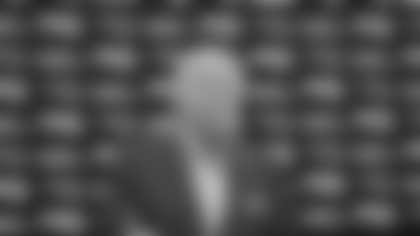BB: All right. How's it going here? Got the No-Doz going? [It's] not really too much different from kind of where we were scheduled to go [going] into the day. Took 64 with [Jordan] Richards; [he] has been a good player at Stanford. He kind of plays both strong safety and free safety. [He's] been a real productive guy for them. I think he's a guy we'll like [and] you'll like having around here. Then Geneo Grissom is a player that has played a couple different spots, converted from tight end to linebacker or defensive end, whatever you want to call it. He played defensive end in '13, played outside linebacker; he's also played inside in some passing situations. [He's a] pretty athletic, versatile guy in Oklahoma's defense over the last couple of years. [We're] looking forward to working with both of them, along with Malcom [Brown]. [We'll] just see how it goes with that group. And we traded to tomorrow, so we ended up with seven picks for tomorrow, so we're kind of spaced pretty evenly throughout the rounds in the draft. I think we've got a good, nice opportunity there in terms of a flow to be able to sequentially make some picks if we hold on to them. We'll see how that goes. But I think there are a number of interesting guys that are on the board. We tried to get the picks into that sort of area of the draft, so hopefully we'll be able to grab some players that we like in those spots. That's it.
Q: You mentioned Richards played both safety spots. Can you elaborate?
BB: Well, you know, you can see him in the box; you can see him in the middle of the field. You can see him doing pretty much everything.
Q: Did he come down and play on the line of scrimmage at all?
BB: He dropped into the box a lot. They didn't really play him, no. They didn't really play their safeties that way – like linebackers. But most of the time they played on the line, [they] disguised it. But he's down around the line of scrimmage a lot, but he doesn't line up as a linebacker.
Q: It seemed like he took a lot of pride in knowing everyone's assignment on the defense. What was your assessment of that?
BB: Yeah, real good. I don't think – everybody you talk to, they rave about it; about his communication, his leadership, his football character on and off the field. I don't think there's going to be issues with that.
Q: Grissom versatility-wise almost didn't have a home or a position because they were moving him around.
BB:No, I wouldn't say that.
Q: End-of-the-line?
BB:In 2013, they played 3-4 defense. He's played under two different coordinators. But when Mike Stoops came back, his 3-4 defense and they didn't have enough depth there at defensive end, so he played four-technique, actually four-high technique in 2013 at 260 pounds. So he was way undersized, but he competed well. They didn't knock him off the line of scrimmage. He didn't look like a linebacker.
You wouldn't probably think he was that light, if you didn't know it, not by the way he played. He has good playing strength. He runs well. Then this year, it looked like they had more depth on the defensive line, they moved him to outside linebacker. So both last year and this year on third down he played end and then also bumped inside to an inside rusher position. They had pretty good edge guys, you know [Eric] Striker and the other kid, the underclassman. He was kind of the guy that would move down inside at times. He was productive there; the Alabama game for example. He's rushed inside, he's rushed outside. He's played anywhere from the end of the line, five-technique, defensive end in a 4-3, outside linebacker in a 3-4.
Q: How much did that Alabama game stick out to you?
BB:I'd say he's pretty disruptive in every game. He has plays in every game. It's not like you have to watch four games to find him making a play. He's been a hard guy to block in that league. There are a lot of teams that throw the ball. You watch Texas Tech, TCU, games like that, there are 50 passes in the first half.
Q: He also seemed to have some ability to anticipate the passing lanes in terms of getting up and batting balls.
BB:Yeah, I'd say he's very instinctive as a pass rusher. He's in coverage a decent amount of the time as a walked-off linebacker. So you see a guy play out in space, out over the slot. He does a lot of that. So, for a guy to play from three-technique to end-of-the-line to a walked-out linebacker…at the Senior Bowl, they actually played him off the line, like in the tackle bubble. He's a pretty athletic, versatile guy.
Q: Are there any similarities between Rob Ninkovich and Grissom's skill sets?
BB: I think there are some similarities. I would say that Grissom has just done more than Rob. Similar to Rob, but he's played a lot of three-technique. Which, I don't think, Rob just hasn't done a lot of that. Rob's been on the end of the line, he's been a linebacker. Rob's played more linebacker than Grissom has. Grissom's played in the inside part of the defensive line. Not just on passing downs, he's played there on their base defense in '13. He's an interesting player.
Q: Did I read that he actually worked out at tight end at his pro day?
BB: He played tight end. He came to them as a defensive end. Then he went back to tight end, then they had some injuries, then he went back to defense. Then he played defense the last two-plus years. I think he had a whole spring at tight end. He did work out as a tight end.
Q: Is that any kind of consideration?
BB: No, we're not trying to make him a tight end, but I'd say that his workout as a tight end is probably as good of a tight end workout as we saw all year. This guy can run, he can catch. If you didn't know he didn't play tight end, you would look at the workout and say, 'That's a pretty good looking tight end.'
Q: Did you see the work of Richards on special teams? How did he impress you there?
BB:Good, really good. Both those guys I think will have a role in the kicking game. Richards is a strong tackler, instinctive guy. I think he'll be a good, certainly be able to play on the punt team, kickoff return, kickoff coverage, punt return; even be a matchup guy outside maybe or a holdup guy in the box. I'm sure he'll be able to contribute in the kicking game.
Q: When you look at guy like Grissom who went through different coaches and coordinators…
BB: Just two.
Q: How does that affect the process when you're looking at prospects?
BB: Look, there's some guys we talk to who had, you know, five coordinators, five position coaches, four coordinators, five position coaches. I'd say he's had a lot of stability. It's unusual really to talk to a kid that's had the same coordinator, same position coach for his whole time at the school. I wouldn't say rare, but I'd say the exception is multiple coaches as opposed to just one.
Q: You said you felt like there were a number of intriguing players on the board and you have a number of picks for tomorrow. Do you feel pretty good heading into tomorrow?
BB:Yeah, I think where we were at the start of the day, we had a little bit of spacing there: top of the fourth, bottom of the fourth, no fifth, but top of the sixth, top of the seventh, bottom of the seventh. Now we've kind of filled in. We have three picks in the fourth round and we've kind of filled in that fifth round at 147 or whatever it is. So, that's seven picks in the rounds remaining, kind of with the spacing they have. It's nice. It's a little bit unusual. Normally you pick and wait, pick and wait. Here we've kind of got, I'd kind of say a little bit of a flow. If we lose a guy, then it's not too far where we're probably going to be able to get the next guy versus you lose a guy and then you're sitting there for 20-something picks, whatever it is, and you're probably going to lose a couple more guys. I'd say there a number of players that we still feel like can be a positive factor for us. We'll see how all that plays out. There are guys that at least right now we want to pick. So, hopefully we'll get some of them.
Q: Most people saw Richards going further down the draft. When you look at him, was his skill set, specific to you, a good fit at that spot?
BB: You know, we always look at the board, look at the options, look at the players and take the guy we feel is best. That's what we do on every pick. It's what we do.
Q: He's obviously a smart kid in the classroom and on the field. Is there always a correlation there?
BB:No, no, definitely not, absolutely not. There just isn't. Some guys are football smart and they're not smart in other ways. Other guys get 1500 on their SATs and can't get a double-team block right. No, that definitely, in my experience, sometimes it correlates, sometimes it doesn't. I don't think you just take it for granted. I think a smart guy can learn. Some guys learn – it's just like all of us – some guys can learn electronics, some of us can't. Some people can learn something else, some of us can't. I mean, we're all wired differently. Some guys, football comes really easy to them; they can see what all 22 players are doing, can see what all 11 guys are doing on their side of the ball, how it all fits together. It's easy for them. For other guys, once you get past their assignment, the big picture, the overall concepts, how it all fits together, sometimes that doesn't come so easy for them. Depends on what position they play, but they're all different. But I would say in his case, he's a smart, instinctive football player and the rest of it is good too. I mean, so is Grissom.
Q: How do you rank the intangibles of him coming from a football family – his dad played and coached at Tufts. Does that play some type of role in the evaluation?
BB:I think you've got to look at each one separately. There are a number of kids in this draft that have those kind of connections, I'd guess you'd call them, with either family members, fathers, uncles, whatever, and that's in varying degrees. It maybe adds up. Sometimes it doesn't add up.
Q: Were you in the NESCAC at the same time as his dad?
BB: I don't know. What years was he there?
Q: '75-'79.
BB: Yeah, I was '71-'75. I don't know.
Q: What is it about the Stanford program that David Shaw and Jim Harbaugh before him run that has these guys NFL ready in terms of being mentally capable as well as physically?
BB: Well I mean, I'm sure when Jim [Harbaugh] was out there, he probably ran as close to an NFL program as – that's what he knew. That's Nick [Saban] at Alabama or Greg [Schiano] when he was at Rutgers or Pat [Hill] when he was at Fresno or Kirk [Ferentz] when he was at Iowa. You know those guys that have gone back into college football from the NFL a lot of times just take whatever they did as an NFL program, so the players are kind of accustomed to those demands. I mean, it's different because they're going to class and all that, I get that, but just the football part of it: the meetings, the walkthroughs, the offseason program, all the demands of the program, the training, the film study on their own, all those things, whatever they are. Then when they come into this league, a lot of times it's an adjustment, but it's not as much of an adjustment. I don't know. I can't speak specifically to that program, but from what I understand – we have Cam [Fleming], we have Tyler [Gaffney] – we have guys you can talk to about that. They didn't seem to be overwhelmed by our program. I'm not saying that wasn't a jump, but not like we might see from some other guys – terminology, all that stuff. But if that's what you're used to, it maybe doesn't seem all that bad.
Q: Are there any positions you think you need to address on your roster?
BB: We'll do what we do with every pick: we'll take a look at the options and do what we think is best. [We] can't manufacture players. Whatever is up there is up there and we'll see how that extrapolates into our roster and our opportunities. I think at this point there's a little bit of draft strategy involved too. Maybe you think you need to take – maybe you might have one guy rated higher than the other, but you might want to take the lower rated guy first because of draft strategy, somebody else you think might want him or whatever. So there's sometimes a little bit of that. Each situation is different, each pick is different, each player is different, so how they fit on to the team and how we would see it, we'll just evaluate each situation on its own. I can't really sit here and say what we're going to do, although it's nice tomorrow to be able to have the second pick, so we only have to think of one team before us instead of 31 where you really don't have any idea what's going to happen in those 31 picks. At least with the one pick, as long as you have two guys, you going to get one of them, if in fact we stay there and pick. So, we'll see how it goes.








































